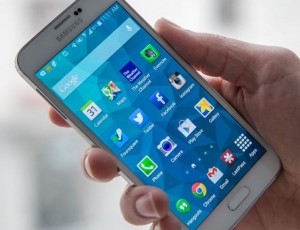Displays – At least, not as much as they used to. In our era, hardware – including displays – quickly becomes commoditized.
That is not to say that you can’t obtain a temporary competitive advantage with a dazzling display: the thin Samsung edge-lit “LED” TV, the Apple Retina and the Asus Zenbook NX500’s 4k, quantum-dot-enhanced display. And you can hurt yourself by falling behind the curve. When Apple saddled its iPhones with a ridiculously small 4″ display for a couple of years longer than it should have, Samsung picked up significant market share. (Apple still plays in a somewhat different universe from the rest of us, so it reaped record breaking sales with the iPhone 6 simply by catching up with the competition.)

Samsung makes the phone; Google makes the money.
But the business model by which handset companies could maintain large margins by upgrading the hardware a couple of times a year is rapidly losing its effectiveness. Sony is learning how hard it is to make money in the high-end smartphone business when you’re not in the top four, and Samsung is learning that you can’t maintain margins even when you’re Number One.
On the TV side, we may ogle large 4k (or 8k) screens with quantum dots or OLEDs, but more TV watching is done on small screens than large ones, particularly by the youthful. And even sales of tablets, on which much of this small-screen viewing is done, are stabilizing because many consumers see little reason to upgrade.
So what drives the action if hardware doesn’t? My friend and colleague Richard Windsor (otherwise known as RadioFreeMobile.com), argues convincingly that it is the customer’s “digital life,” and the companies that provide the most compelling of the digital media and services that constitute a user’s digital life are the companies that will prosper. And if a company can make its digital ecosystem sufficiently compelling – or sufficiently difficult to leave – users will spend more and more of their digital life within one digital ecosystem.
Thus, Google and Apple prosper. Microsoft has seen the light and is working hard to expand the digital ecosystem surrounding its Xbox and Windows platforms. (Disclosure: I am not a gamer and do not own an Xbox console, but I am a happy subscriber to Xbox Music. I’m listening to Artie Shaw as I write this. The same user ID and password that get me onto my Windows computer also get me into my Xbox Music account by default. This digital ecosystem stuff is sneaky.)
Google, Windsor tells me, is shrinking the public core of Android and making proprietary more and more of what matters. Thus, it is Google that will control most of the digital ecosystem that is accessed on Android phones, leaving the low-margin hardware to the handset makers. It now becomes easy to see why Samsung is hurting. Apple, of course, controls both its hardware and digital ecosystem, so it is likely to continue to do well even if the margins on its hardware decrease.
Sony is an interesting case. With its Playstation game platform and very successful movie and music divisions, you would think Sony could have been able to establish a compelling digital ecosystem to drive hardware sales. And Sony said it was doing so since the days when Howard Stringer was CEO. But the game division, although successful, stood more or less apart, as did the media divisions. And the phones ran Android and the computers (while they lasted) ran Windows. How could these devices access Sony music and movies any better than competing products? They could have, just as subscribers to Amazon Prime have preferred access to a wide variety of music and movies, but Sony never seemed able to put that together.
So we are now in the era of digital life. The display – and the device in which it sits – is the window to that life. The window must be large enough and clear, but it is the life beyond the window for which users are willing to pay. – Ken Werner

